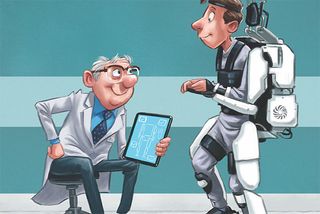Making great strides: invest in the future of prosthetic medicine
Intelligent artificial limbs, medical exoskeletons and devices that link artificial limbs directly with the brain may sound like science fiction, but they are getting closer. Which stocks will profit? Matthew Partridge reports.


When we think of medical technology, miracle drugs and biotechnology tend to spring to mind. However, medical devices, long considered the poor cousin of the healthcare industry, have been undergoing a quiet revolution. Intelligent limbs, which mimic the action of the original body part, and exoskeletons robotic suits designed to aid movement are starting to be go mainstream. Even medical devices that can communicate directly with the human brain may not be as far off as you think. What's more, with medical and social-care systems struggling with age-related problems, the long-term demand for such devices will be immense.
Artificial limbs are getting more sophisticated
Artificial limbs have existed for thousands of years. But in the 1990s new types of "intelligent" prostheses emerged. Instead of being passive lumps of metal, plastic or wood, these came with electronics and hydraulics that allowed them to function in a way that anticipated and supported users' movements rather than just remaining rigid. Unfortunately, despite their benefits to patients who had lost limbs, they tended to be expensive, bulky and required recharging after only a short time, which limited their appeal.
Fortunately, this is beginning to change. There has been a "huge amount of progress over the past five to ten years in the quality of the most advanced prosthetics", says Dr. David Moser, head of research at Blatchford. For example, developments in microprocessor technology mean that the limbs are much better at tracking and predicting the motion of the user. Not only do they capture a much larger amount of data, but they also spot behavioural patterns. The microprocessor collects the pattern data and uses it to send instructions to the mechanical elements that then move the limbs.
Subscribe to MoneyWeek
Subscribe to MoneyWeek today and get your first six magazine issues absolutely FREE

Sign up to Money Morning
Don't miss the latest investment and personal finances news, market analysis, plus money-saving tips with our free twice-daily newsletter
Don't miss the latest investment and personal finances news, market analysis, plus money-saving tips with our free twice-daily newsletter
Advances in limb technology are also allowing much more complex devices to be created. While the first generation of intelligent limbs focused on one joint, such as the foot, some of the most sophisticated of the current generation of artificial limbs "are now able to control multiple joints together", says Moser. For example, Blatchford's Linx system "enables integrated control of knee and foot by an internal computer". This allows those who have had their limbs amputated above the knee to walk, something that would have been impossible with the previous generation of intelligent prosthetics.
Controlling prostheses by smartphone
In addition to improvements in quality and complexity, the weight and bulk of the limbs is also starting to decrease. Smaller microprocessors and better materials mean that they are lighter and consume less power, so they are more comfortable and need not be recharged so frequently. Some of the devices can even be controlled from the user's smartphone. Finally, and perhaps most importantly from the perspective of a cash-strapped healthcare system, they are becoming cheaper, making them a realistic option for a far wider range of patients. Overall, today's artificial limbs "are much more stable and smoother than they were a few years ago, providing a greater quality of life for the patient", says Moser. Not only are patients using them able to perform tasks that were previously impossible, such as walking and even playing sports, but there are also less obvious benefits. In addition to improved mental health from the increased independence, using an intelligent artificial limb instead of a conventional prosthesis can reduce the mental effort (what Moser calls the "cognitive burden") involved in everyday movement. It can also reduce the long-term skeletal problems that occur when users adjust their posture to compensate for the prosthesis.Of course, even today intelligent artificial limbs are still very far from reaching their full potential. However, Moser expects further improvements. Some of this will come in the form of artificial intelligence better able to anticipate users' movements, allowing the limbs to operate with an even higher degree of accuracy. Similarly, the technology that is allowing multiple joints to be connected together will also improve rapidly over the next decade. Meanwhile, an increasingly older and frailer population, both in developed countries and in emerging markets, will ensure that demand for high-quality artificial limbs continues to grow rapidly.
The cutting-edge of device technology
Artificial limbs are clearly important, but exoskeletons represent the real cutting-edge of medical device technology. Working like the bionic suits in the Iron Man films, these wearable robotic devices are designed to support, augment, or even replace the movements and limb functions of the user's body. The original impetus for exoskeleton technology came from the military, which was interested in finding ways to make soldiers stronger. However, like other military technologies, exoskeletons "have gradually made their way into medicine", says Dr. Arun Jayaraman, associate professor of physical medicine and rehabilitation at the Shirley Ryan AbilityLab of Northwestern University.
Exoskeletons "are going through a spurt of development that is roughly as fast as that experienced by smartphones ten years ago", says Jayaraman. While there were only four major companies a decade ago, there are now "over a hundred start-ups", all looking for a device that will change the industry. This competition has expanded both the quality and quantity of robots available.
Indeed, while the first commercial design did not reach the market until 2009, there are now a wide range of models on the market. They focus on four main areas. Most medical exoskeletons "are essentially mobility robots aimed at patients who are paralysed, allowing them to control their limbs (via the machine) and therefore regain a degree of mobility and freedom". However, therapy robots "can also help those with less serious injuries who are doing exercises" such as running on a treadmill as part of a physical therapy programme, helping to cut the risk of an additional injury. Performance augmentation robots help people with chronic conditions such as multiple sclerosis (MS) or arthritis go about their daily lives. Recreational robots help patients "continue to enjoy... strenuous activities, like sports, that would otherwise be off-limits".
Despite these recent advances, there are several factors preventing more hospitals from using them. A single exoskeleton can currently cost around $40,000; the more expensive models sell for more than $200,000. This can make their use hard to justify when government money is tight. The motors and robotic equipment contained in the exoskeletons can also make them bulky and difficult to use for long periods, while some patients feel extremely self-conscious about how they look when wearing them.
A vast potential market
Fortunately, exoskeleton manufacturers are beginning to overcome these problems. Like artificial limbs, the size and weight of exoskeletons is constantly decreasing as companies develop new composite materials and the electronic components continue to shrink. Even at this early stage there are signs that patients are becoming more comfortable wearing the devices; Jayaraman has noticed that some are even expressing a preference for models that give them a "Terminator look". Economies of scale should also ensure that costs of production should start to fall significantly as more are manufactured, which in turn should boost demand further. Grand View Research expects the wider exoskeleton market to reach $3.3bn by 2025.
However, the size of the market could be even bigger, especially if insurance companies and healthcare authorities agree to cover the use of exoskeletons, which is starting to happen. Alex Hunter, co-manager of Global Equity Opportunities at Sarasin & Partners, notes that Japanese company Cyberdyne has signed a contract with the German Public Employees Insurance Fund that finances exoskeletons for MS, Parkinson's and stroke patients covered by the fund. If all the 30 million people suffering from those ailments in developed countries received the same support then the total market would be worth $900bn for these diseases alone.
Connecting devices to the brain
At present both artificial limbs and exoskeletons need some external input to function. In many cases, this isn't necessarily a fatal flaw since the devices can use tracking movements in the rest of the user's body to predict the direction that they will move in. Failing that they can even be directed from a device controlled by the patient. However, this means that they can struggle to deal with unexpected movements and are useless for those who are completely paralysed. Even more advanced systems tracking activity in the nerves next to the device don't work if there is something preventing the signal from the brain reaching the area. As a result, the ultimate goal of prosthetic and exoskeleton technology is a device that allows activity in the brain to be transmitted to the artificial device without the need for an intermediate connection such as the nervous system. So the devices would essentially be operated by thought. Building such a "brain-computer interface" is very difficult because it requires researchers to understand how the brain works and then devise a system for transmitting and decoding this activity in a way that devices can understand.
Paraplegics could regain control of their limbs
Nevertheless, there has been rapid progress in the last decade. Several experiments have "demonstrated that it is possible to use invasive brain-computer interfaces to control prosthetic limbs", says Dr Fani Deligianni of Imperial College London. Three years ago French researchers demonstrated that by implanting microelectrodes into the motor region of monkeys' brains, it was possible for them to "gain precise control of an advanced robotic arm, and learn to grasp its food within a couple of days".
In theory the same techniques used in the monkey experiments could be used to "allow paraplegic people to do dexterous movements and control robotic fingers for grasping". Unfortunately, they can't currently be used in humans because the experiments involved physically implanting wired electrodes into the brains of the subject. This created an unacceptably high risk of complications. As a result, researchers are now focusing on non-invasive brain computer interfaces.
However, such interfaces produce data that is "noisier and less precise" and require "accurate brain maps acquired with an MRI scanner". Despite these limitations, a growing number of companies are trying to produce brain-computers that can be sold commercially. This summer Elon Musk, the founder of Tesla, predicted that trials of his Neuralink brain implants could start before the end of 2020. Musk predicts that the devices, which are one-tenth the width of a human hair, are Bluetooth-compatible and could be used to enable telepathy, will help stroke victims recover and even give a memory boost to otherwise healthy people.
The Australian start-up Synchron has actually begun an early stage clinical trial of its minimally invasive device that is implanted into the brain via the bloodstream and allows thoughts to be translated into digital speech. While the initial trial will involve just ten people, "if things go well, there will be a large trial with more patients", says Dr Thomas Oxley, Synchron's CEO. Overall, he thinks they may well be able to bring a product to the market within five years. Of course, digital speech is only the tip of the iceberg.
"Once you have found a way to digitise intent by building a control language that can interact with a machine, you can apply this to other aspects of brain activity, such as the parts of the brain that deal with the motor skills." This in turn could be used to enable paralysed patients to control exoskeletons and prosthetics. With around 60 million patients currently suffering from paralysis the total value of the potential market could be around $2trn.
The stocks to buy now
ssur (Copenhagen: OSSR) is one of the world's leading manufacturers of prosthetics. Alongside conventional ones, it produces a range of "bionic limbs".
It is also developing techniques for embedding so-called myoelectric sensors into the residual tissue of amputated limbs, which are then connected to the leg, allowing them to be controlled by the user. The prosthesis is controlled with electrical signals generated by the patient's own muscles.
While this isn't quite the instinctive control promised by brain-computer interfaces, it represents the current cutting-edge of technology. Although ssur trades at 31 times 2020 earnings, this is more than justified by the fact that earnings per share have grown at a rate of 15% a year over the past five years.
Parker Hannifin (NYSE: PH), a company that specialises in motion and control technologies, has recently started using its expertise to develop exoskeletons. Three years ago it received a major boost when its Indego exoskeleton was approved for medical use by the US Food and Drug Administration (FDA).
Since then the FDA has greatly expanded the range of conditions that it can be used for, while Parker Hannifin has also developed another model aimed at helping patients who are undergoing physical therapy. Even though earnings have been growing at double-digit rates, the stock currently trades on a 2020 price/earnings ratio of 14.2.
If you want to invest in a company that focuses exclusively on exoskeletons, then consider Cyberdyne (Tokyo: 7779), which developed the Hybrid Assistive Limb (HAL), generally regarded as the first civilian exoskeleton. The company has "successfully transitioned from an idea to a nascent business and from a nascent business to a fully fledged commercial operation with credible external orders", says Alex Hunter, co-manager of Global Equity Opportunities at Sarasin & Partners.
Although the group is not yet making a profit, a contract with the German Public Employees Insurance Fund, which owns a quarter of the shares, provides some stability.
Ekso Bionics (Nasdaq: EKSO) is another pure play on exoskeleton technology, although it also makes industrial exoskeletons. Its flagship exoskeleton EksoNR, now available in over 270 centres, helps patients who have suffered strokes to learn how to walk again.
Ekso has also released a new rehabilitation device focused on the upper body called EksoUE. This is not a share for the faint-hearted as the price has been extremely volatile and the company continues to lose money. However, surging sales mean that it is now close to breaking even, and it has plenty of cash on hand.
ReWalk Robotics Ltd (Nasdaq: RWLK) is in a similar financial position to Ekso Bionics, as a doubling of revenues means that it is within sight of being profitable. At present the group offers two main products: a rigid exoskeleton for those with spinal-cord injury, and a soft exosuit aimed at those undergoing therapy after suffering a stroke, which reached the market last summer.
Both products have received regulatory approval in the United States and elsewhere, with the rigid exoskeleton now covered by several major insurers.
Matthew graduated from the University of Durham in 2004; he then gained an MSc, followed by a PhD at the London School of Economics.
He has previously written for a wide range of publications, including the Guardian and the Economist, and also helped to run a newsletter on terrorism. He has spent time at Lehman Brothers, Citigroup and the consultancy Lombard Street Research.
Matthew is the author of Superinvestors: Lessons from the greatest investors in history, published by Harriman House, which has been translated into several languages. His second book, Investing Explained: The Accessible Guide to Building an Investment Portfolio, is published by Kogan Page.
As senior writer, he writes the shares and politics & economics pages, as well as weekly Blowing It and Great Frauds in History columns He also writes a fortnightly reviews page and trading tips, as well as regular cover stories and multi-page investment focus features.
Follow Matthew on Twitter: @DrMatthewPartri
-
 Ofgem considers lifting ban on cheaper energy deals for new customers
Ofgem considers lifting ban on cheaper energy deals for new customersOfgem says that ‘now is the right time’ to remove the ban that allowed energy suppliers to offer exclusive deals at low prices to new customers
By Oojal Dhanjal Published
-
 Santander returns with £175 switching bonus – should you move banks?
Santander returns with £175 switching bonus – should you move banks?Santander has reappeared with a bank switching incentive offering £175 if you switch your current account to one of its packaged bank accounts. Are the Santander account perks any good?
By Vaishali Varu Published
-
 Invest in space: the final frontier for investors
Invest in space: the final frontier for investorsCover Story Matthew Partridge takes a look at how to invest in space, and explores the top stocks to buy to build exposure to this rapidly expanding sector.
By Dr Matthew Partridge Published
-
 Invest in Brazil as the country gets set for growth
Invest in Brazil as the country gets set for growthCover Story It’s time to invest in Brazil as the economic powerhouse looks set to profit from the two key trends of the next 20 years: the global energy transition and population growth, says James McKeigue.
By James McKeigue Published
-
 5 of the world’s best stocks
5 of the world’s best stocksCover Story Here are five of the world’s best stocks according to Rupert Hargreaves. He believes all of these businesses have unique advantages that will help them grow.
By Rupert Hargreaves Published
-
 The best British tech stocks from a thriving sector
The best British tech stocks from a thriving sectorCover Story Move over, Silicon Valley. Over the past two decades the UK has become one of the main global hubs for tech start-ups. Matthew Partridge explains why, and highlights the most promising investments.
By Dr Matthew Partridge Published
-
 Could gold be the basis for a new global currency?
Could gold be the basis for a new global currency?Cover Story Gold has always been the most reliable form of money. Now collaboration between China and Russia could lead to a new gold-backed means of exchange – giving prices a big boost, says Dominic Frisby
By Dominic Frisby Published
-
 How to invest in videogames – a Great British success story
How to invest in videogames – a Great British success storyCover Story The pandemic gave the videogame sector a big boost, and that strong growth will endure. Bruce Packard provides an overview of the global outlook and assesses the four key UK-listed gaming firms.
By Bruce Packard Published
-
 How to invest in smart factories as the “fourth industrial revolution” arrives
How to invest in smart factories as the “fourth industrial revolution” arrivesCover Story Exciting new technologies and trends are coming together to change the face of manufacturing. Matthew Partridge looks at the companies that will drive the fourth industrial revolution.
By Dr Matthew Partridge Published
-
 Why now is a good time to buy diamond miners
Why now is a good time to buy diamond minersCover Story Demand for the gems is set to outstrip supply, making it a good time to buy miners, says David J. Stevenson.
By David J Stevenson Last updated